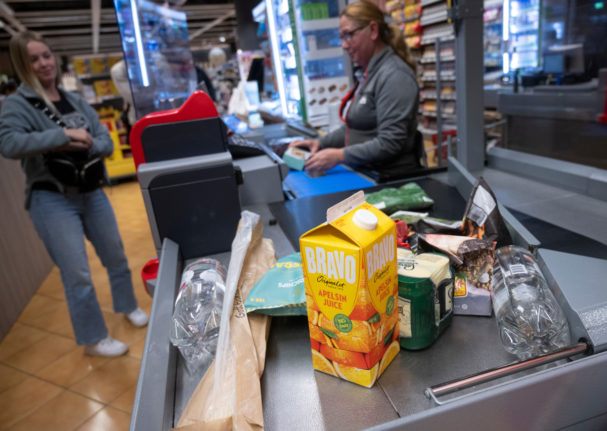Hej,
I had a video call with an old university friend the other day and the main topic of our conversation was… mortgages.
Let me tell you, this is NOT what we used to talk about at uni.
We’re both looking to buy a new home in the next few months, and are struggling to make sense of all the various interest rates, inflation rates and mortgages. It’s hard to know exactly how the economy is going to affect us this year.
On the one hand, the Swedish economy seems to be in remarkably decent shape despite all the doom-and-gloom forecasts at the beginning of the year. On the other hand, everyone I know in Sweden is worried about the rising costs of living.
My friend, not based in Sweden, asked me a bunch of questions. Here’s how I tried to explain the situation:
What’s Sweden’s current rate of inflation?
Sweden’s year-on-year rate of inflation fell to 9.3 percent in June, down from 9.7 percent in May, according to the Consumer Price Index (CPI) as measured by number-crunchers Statistics Sweden, who announced the news on Friday.
If you instead look at the CPIF metric (which is basically the same as CPI but with fixed interest rates, removing the cost of mortgages from the equation), inflation fell from 6.7 to 6.4 percent.
What are the main drivers behind inflation right now?
In June, which is the latest month we have data for, higher interest expenses for home-owners were the main factor behind the still rather high inflation rate, contributing 3.1 percentage points.
Other drivers were food prices, hotel and restaurant visits, and price increases on recreational and cultural activities, including package holidays and international flights. Shopping for clothes, shoes, furniture and household goods also contributed to the inflation rate, said Statistics Sweden.
In other words: typical summer activities.
How does all of this affect me?
Well, if you’re a home-owner, or even if you’re renting, you’re probably paying much higher interest on your mortgage than you were this time last year. If you’re living in a BRF housing association (the most common form of apartment ownership in Sweden), your BRF’s own loans are likely more expensive, perhaps leading to higher fees for you.
In fact, interest expenses for BRF apartment-owners have increased by more than 100 percent since June last year, and interest expenses for other kinds of home-owners have gone up 88 percent.
You can probably expect mortgage rates to keep rising. The fact that inflation fell in June may seem like a good sign, but the problem is that experts had expected it to fall even further.
Sweden’s underlying inflation still remains high, and this will affect by how much the central bank, the Riksbank, decides to raise the country’s main interest rate (which currently stands at 3.75 percent) at its next meeting in September.
This in turn affects how banks set their interest rates on mortgages.
The Riksbank uses the CPIF as its metric, so that’s with increasing mortgage rates removed, but 6.4 percent is still much higher than its target rate of two percent.
It generally hopes that by increasing the main interest rate it will be able to push inflation down – which is happening, but slowly.
Even if you’re not a home-owner, your cost of living has probably increased in the past year.
The cost of international flights was 31 percent higher in June compared to last year, the cost of food was 13 percent higher, clothing and footwear 6 percent higher and restaurants 8 percent higher.
Electricity and fuel, however, cost 10 percent and 16 percent less, respectively, than last year.
If things are so expensive, why is the economy still trudging ahead?
Do you remember that the EU Commission predicted back in February that the Swedish economy would fare the worst of all EU countries this year? Its forecast stated that Sweden’s GPD would contract by 0.8 percent this year, the only economy in the union to shrink rather than grow.
Yeah, that didn’t happen. Nor did a predicted spring recession ever materialise.
In fact, the Swedish economy has proven to be remarkably and unexpectedly resilient this year. According to the latest report, Sweden’s GPD even increased in May.
Yay? Not necessarily. Higher growth leads to increased pressure on inflation.
So if the cost of living is higher, why are people still spending and pushing inflation up?
When they’re not blaming Beyoncé, experts believe that consumers in Sweden are currently using their savings to keep buying things, which is what’s keeping the economy going.
But come autumn when savings start to run low, things may become more difficult for consumers and the economy.
At around the same time, mortgage rates will probably increase (especially if the Riksbank raises the interest rate in September) as will the price of electricity in the colder months.
It might make sense not to spend all your savings this summer and keep as much as possible of your buffer.
What happens next?
Two key dates: Statistics Sweden is set to present Sweden’s next inflation update on August 15th, and the Riksbank will decide whether or not to again raise the interest rate on September 20th.
I hope this explanation from a non-economist helped. Thanks for reading!
Best wishes,
Emma Löfgren
Editor, The Local Sweden
Inside Sweden is our weekly newsletter for members that gives you news, analysis and, sometimes, takes you behind the scenes at The Local. It’s published each Saturday and members can receive it directly to your inbox, by going to your newsletter preferences.



 Please whitelist us to continue reading.
Please whitelist us to continue reading.
Well described Emma! We were discussing with my wife on nowadays’ economic situation in Sweden (we live in Malmö) and I think that your article summarized things perfectly!
I’m glad to hear that, thank you! /Emma